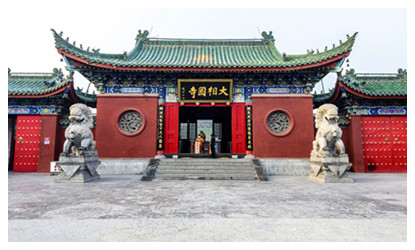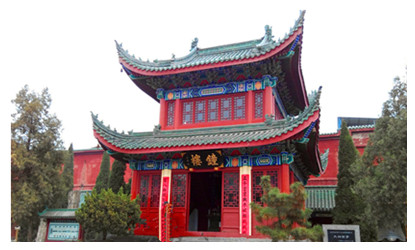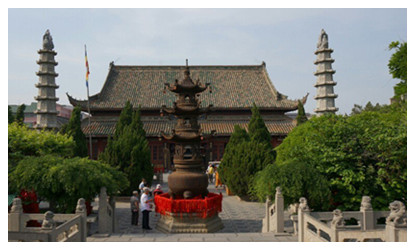Skype: neodalle-travel
Tel: +86 135 7447 2266
E-mail: sales@zhangjiajieholiday.com
Xiangguo Temple, situated on the west of Ziyou Road, Kaifeng City, Henan Province, is one of the ten famous temples in Chinese history. It plays an important role in the development of Buddhism in China.
History of the Xingguo Temple
 The Grand Xiangguo Monastery was originally built in 555 during Northern Qi Dynasty (550-577) on the base of the residence of Xinlingjun, who was a prince of the Wei Kingdom during the Warring States Period (220 -280) in ancient China.
The Grand Xiangguo Monastery was originally built in 555 during Northern Qi Dynasty (550-577) on the base of the residence of Xinlingjun, who was a prince of the Wei Kingdom during the Warring States Period (220 -280) in ancient China.
The monastery was damaged by wars and fire and then was re-built in 711 during Tang Dynasty (618-907), named Jian'guo Monsnatery. In 712, Emperor Tangruizong granted the monastery a plaque with the name of "Grand Xiangguo Monastery" on it in honour of his inheriting the throne.
The temple reached its heyday in the Song Dynasty (960-1279). It became an international Buddhism center, attracting many foreign envoys and great monks. It contributed a lot to the cultural exchanges between China and other countries.
The situation lasted until Ming Dynasty (1368-1644), the founder (Zhu Yuanzhang) of which was a monk before he gained the throne. During his reign, the monastery was repaired for several times, but it was renamed to be "Chongfa Monastery" by Zhu's offspring in 1474.
In 1642, a big flood from the Yellow River damaged the monastery and it was not re-constructed until 1766 when it was Qing Dynasty (1644-1911). In 1746, a big repair project conduted by Emperor Qianlong was started, which lasted for two years and seven months and made great to the recovery of the monastery. Unpredictably, the Grand Xiangguo Monastery was attacked by the Yellow River once again and it almost became a ruin.
In 1993, the Lingshan Temple of Singapore presented the monastery with the sarira of Sakyamuni (founder of Buddhism), which is now still enshrined there. All the figures of Buddhas in every hall of the monastery are perfect in workmanship and seen as the gem among their analogues in China.
What to see ?
 Coming here, you will be surprised at the magnificent architecture and the well-arranged layout of the Xiangguo Temple. The existing structures were mainly built in the Qing Dynasty (1644-1911). The buildings include Mountain Gate, Paifang, Heavenly Kings Hall, Daxiongbaodian Hall (Hall of Sakyamuni), Arhat Hall and Sutra Hall. They are set on the north-south central axis with some other annexes built symmetrically on both sides.
Coming here, you will be surprised at the magnificent architecture and the well-arranged layout of the Xiangguo Temple. The existing structures were mainly built in the Qing Dynasty (1644-1911). The buildings include Mountain Gate, Paifang, Heavenly Kings Hall, Daxiongbaodian Hall (Hall of Sakyamuni), Arhat Hall and Sutra Hall. They are set on the north-south central axis with some other annexes built symmetrically on both sides.
Stepping through the gate, you will first see the Bell Tower and Drum Tower as in most Buddhist temples. The bell hanging here weighs five tons and is 2.23 meters (7.3 feet) tall. Its grazioso sound echoes all over the city, especially in winter. Xiangguo Shuang Zhong (the beautiful sound of the bell on a frosty day) is one of the Eight Scenes of Bianjing (nowadays Kaifeng).
Inside Heavenly Kings Hall sits Maitreya (also called Future Buddha), a stout Buddha with a broad smile on his face and his breast and paunch exposed to the public. The Heavenly Kings are respectively standing beside Maitreya with sword, lute, blue umbrella and silver snake in their hands which represent feng, tiao, yu, shun (The four Chinese characters used to describe the optimal weather for agriculture). Behind Maitreya is the statue of a general called Wei Tuo, the protective god of Buddhism. As the legend goes, after the Nirvana of Sakyamuni, his relics were stolen by the devils. It was Wei Tuo who battled the devils and recovered the relics. He was then revered as Wei Tuo Buddha and worshiped in most Buddhist temples.
 Behind Heavenly Kings Hall is the grandiose Daxiongbaodian Hall (Hall of Sakyamuni), the main hall of the Xiangguo Temple. Three Buddhas are worshiped here. Sakyamuni sits in the middle, Amitabha (Emitofo, guide of the Western Paradise) and Bhaisajyaguru (Yaoshifo, the God of Medicine).
Behind Heavenly Kings Hall is the grandiose Daxiongbaodian Hall (Hall of Sakyamuni), the main hall of the Xiangguo Temple. Three Buddhas are worshiped here. Sakyamuni sits in the middle, Amitabha (Emitofo, guide of the Western Paradise) and Bhaisajyaguru (Yaoshifo, the God of Medicine).
The most remarkable structure in the temple is the Arhat Hall, which is also called Octagonal Glazed Hall. Inside, the towering Octagonal Pavilion houses a wooden statue of Avalokitesvara Bodhisattva, which was carved from the bole of a huge gingko tree during the reign of Emperor Qianlong in the Qing Dynasty. The four sides of the statue are of the same sculpt. On each side, there are six big hands and three to four layers of small fanlike hands, with an eye on each palm. The number of the hands totals 1,048, and likewise the number of the eyes. The statue highly embodies the fine works of the Qing Dynasty. Don't you think it is amazing?
The magnificent two-storey Sutra Hall where the sutras are kept is the last tall building in the temple. It is to the north of Arhat Hall. Glazed lion ornaments line the ridges to the hall, tied with small bells, chiming beautiful music together with the breeze.
In addition, Xiangguo Temple holds annual activities like lantern exhibitions on the Lantern Festival, chrysanthemum exhibitions and the great prayer festival of water and land. On the occasion, pilgrims from home and abroad will assemble here to celebrate the holidays.
At the beginning of the lunar New Year, the annual Lantern Festival is held here. With the shining lanterns, fireworks, and sweet sound of songs and drums, the beautiful Temple foresees the peace and prosperity of the country and the happiness of people. Whenever there are cultural activities, people of all ages rush out to this ancient Temple where they can enjoy themselves through either appreciating beautiful lanterns or participating in various traditional performances. In October, the Temple is fragrant with chrysanthemums. After the opening of the Kaifeng chrysanthemum exhibition, the annual prayer ceremony opens with praying for the peace of the world and the health of the people. The resounding recitation prays for a good harvest, prosperity and peace for the country; the resounding bell ring blesses the prosperity of Buddhism and this ancient Temple.
Travel Tips
Add: No.36, on the west of Ziyou Road, Kaifeng City, Henan Province
Entrance fee: CNY 30
Opening time: 07:00-17:00
 Ask Questions ?
Ask Questions ?